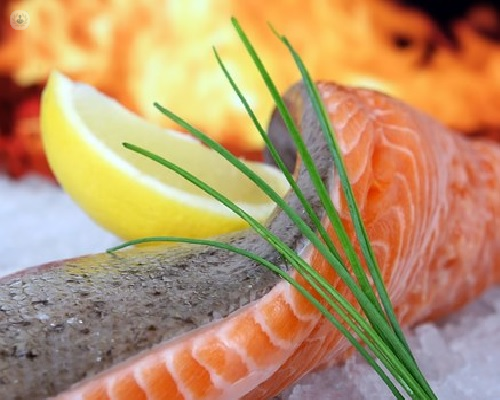Fish, key in a healthy diet
Written by:Since it was observed that cardiovascular diseases in the Eskimos - which consumed significant amounts of marine fats - were significantly lower than in the Danish, there have been numerous epidemiological investigations that show the positive effects of consuming polyunsaturated fatty acids of the series Omega-3 , especially eicosapentaenoic acid (EPA), and docosahexaenoic acid (DHA). And, in addition to the benefits of these fats, it should be remembered that fish is a good source of protein, vitamins and minerals
Proteins
The protein content of fish ranges between 10 and 27% and varies from one species to another, also according to age, time of capture and geographical location. The muscle of fish is different from that of terrestrial animals because it is more digestible and it is metabolized effectively, more than 80%, so that the nutritional use of fish is very high. Remember that proteins are the main constituent of cells that, in addition to providing energy , have the function of forming and repairing body structures.

Fat
On the other hand, fats are part of cell membranes, transport fat-soluble vitamins, contain fatty acids that humans can not synthesize (essential), in addition, fat contributes to the palatability of the diet and intervenes in the regulation of concentration of plasma lipids .
And marine products are a rich source of omega-3 fatty acids, specifically eicosapentaenoic (EPA), which is hypotensive and antithrombotic, docosapentaenoic (DPA), with functions similar to EPA, and docosahexaenoic (DHA), considered as antitumor agent .
Regarding Omega 3 DHA, it is related to brain health during all periods of our life, it is crucial for the correct neuronal and visual development in times of growth as well as for its maintenance in adulthood.
As regards omega 3 EPA, it is a potent anti-inflammatory when competing with arachidonic acid (Omega 6), counteracting its inflammatory potential.
Thus, the intake of fish (especially fatty) balances the Omega6 / Omega 3 ratio that is currently located in the Western world, 15/1, a situation that favors the production of inflammatory eicosanoids, so we should approach 1/1 , which was that of the human being in its origins.
Minerals
Fish is a source of minerals such as calcium, phosphorus, sodium, magnesium, iron, zinc, selenium, copper and especially iodine. Of these, selenium is perhaps not as well known but it is an effective antioxidant that enhances the activity of vitamin E. For example, the enzyme glutathione peroxidase, a potent endogenous antioxidant enzyme, contains selenium. And in marine products the average concentration of selenium is 40μg / 100g, so that 200g of fish covers 150% of the daily recommended requirements. Fundamental is also iodine , an essential component of thyroid hormone, which in marine species - especially molluscs and crustaceans - contain 100μg / 100g, so that 200g of fish cover the daily needs of iodine.
Vitamins
The vitamins are divided into fat-soluble and water-soluble, and the fish contains the two groups. Fatty fish contains more vitamin A and D than lean fish, since marine plankton is very rich in carotenes that are converted to vitamin A , a vitamin that is usually concentrated in fish liver.
In addition, fish is the main source of vitamin D in our diet. The average concentration ranges between 200-600 IU / 100g, although in oily fish they can reach 1500UI / 100g. To get an idea, the recommended intake is 200 IU / day in children under 50, and 400 IU / day in people over 50. In older women, for the prevention of femur fracture, the amount amounts to 800UI / day.
We can conclude therefore that the fish and in general the marine products are of great interest in a healthy diet. Given this, our advice is: prioritize small species to predatory fish, since not feeding on other fish accumulate less heavy metals such as lead, cadmium and mercury. And whenever possible you should avoid farmed fish .


